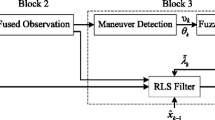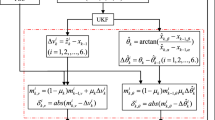Abstract
This paper presents a new method for tracking a zigzag maneuvering target by compensating for the positional error of the target. The positional difference between the measured and predicted points is separated into acceleration and noise. Fuzzy c-means (FCM) clustering is utilized as an adaptive method for noise separation. Approximating acceleration is determined by the membership function of the FCM. The approximated acceleration is used to compensate for the tracking error. The procedures of the proposed algorithm can be implemented as an on-line system. Finally, some examples are provided to show the effectiveness of the proposed algorithm.
Similar content being viewed by others
References
D. P. Atherton, Stability of Nonlinear Systems, John Wiley, New York, 1981.
D. P. Atherton, Nonlinear Control Engineering, Student Edition, Van Nostrand Reinhold, London, 1982.
L. O. Chua, C. A. Desoer, and E. S. Kuh, Linear and Nonlinear Circuits, McGraw-Hill, New York, 1987.
R. A. Singer, “Estimating optimal tracking filter performance for manned maneuvering targets,” IEEE Trans. Aerospace and Electronic Syst., vol. 4, pp. 473–483, 1970.
Y. T. Chan, A. G. C. Hu, and J. B. Plant, “A Kalman filter based tracking scheme with input estimation,” IEEE Trans. Aerospace and Electronic Syst., vol. 15, pp. 237–244, 1979.
B. J. Lee, J. B. Park, and Y. H. Joo, “An intelligent tracking method for a maneuvering target,” International Journal of Control, Automation, and Systems, vol. 1, no. 1, pp. 93–100, 2003.
B. J. Lee, J. B. Park, and Y. H. Joo, “Fuzzy-logic-based IMM algorithm for tracking a maneuvering target,” IEE Proceedings-Radar, Sonar and Navigation, vol. 152, no. 1, pp. 16–22, 2005.
S. Y. Noh, J. B. Park, and Y. H. Joo, “Intelligent tracking algorithm for maneuvering target using Kalman filter with fuzzy gain,” IET Proceedings-Radar, Sonar and Navigation, vol. 1, no. 3, pp. 241–247, 2007.
H. S. Son, J. B. Park, and Y. H. Joo, “SIMM method based on acceleration extraction for nonlinear maneuvering target tracking,” Journal of Electrical Engineering and Technology, vol. 7, no. 2, pp. 255–263, 2012.
M. B. Ignagni, “Separate-bias Kalman estimator with bias state noise,” IEEE Trans. on Automatic Control, vol. 35, pp. 338–341, 1990.
A. T. Alouani, P. Xia, T. R. Rice, and W. D. Blair, “A two-stage Kalman estimator for state estimation in the presence of random bias and for tracking a maneuvering targets,” Proc. of 30th IEEE Conference on Decision and Control, Brighton, England, 1991, pp. 2059–2062.
P. L. Bogler, “Tracking a maneuvering target using input estimation,” IEEE Trans. Aerospace and Electronic Syst., vol. 23, pp. 298–310, 1987.
H. A. P. Blom and Y. B. Shalom, “The interacting multiple model algorithm for systems with Markovian switching coefficients,” IEEE Trans. Automatic Cont., vol. 33, pp. 780–783, 1988.
A. Munir and D. P. Atherton, “Adaptive interacting multiple model algorithm for tracking a maneuvering target,” IEE Proceedings-Radar, Sonar and Navigation, vol. 142, pp. 11–17, 1995.
S. McGinnity and G. W. Irwin, “Fuzzy logic approach to maneuvering target tracking,” IEE Proceedings-Radar, Sonar Navigation, vol. 145, no. 6, pp. 337–341, 1998.
D. Simon, “Training fuzzy systems with the extended Kalman filter,” Fuzzy Sets and Syst., vol. 132, pp. 189–199, 2002.
R. Mikut, O. Burmeister, L. Groll, and M. Reischl, “Takagi-Sugeno-Kang fuzzy classifiers for a special class of time-varying systems,” IEEE Trans. Fuzzy Syst., vol. 16, no. 4, pp. 1038–1049, 2008.
C. T. Lin and C. S. George Lee, “Neural-network-based fuzzy logic control and decision system,” IEEE Trans. Fuzzy Syst., vol. 40, no. 12, pp. 1320–1336, 1991.
J. C. Bezdek, R. Ehrlich, and W. Full, “FCM: the fuzzy c-means clustering algorithm,” Computers and Geosciences, vol. 10, no. 2–3, pp. 191–203, 1984.
R. L. Cannon, J. V. Dave, and J. C. Bezdek, “Efficient implementation of the fuzzy c-means clustering algorithms,” IEEE Trans. on Pattern Analysis and Machine Intelligence, vol. 8, no. 2, pp. 248–255, 1986.
D. E. Goldberg, Genetic Algorithms in Search, Optimization, and Machine Learning, Addison-Wesley, Boston, MA, 1989.
M. Gen and R. Cheng, Genetic Algorithms and Engineering Design, John Wiley and Sons, New York, 1997.
H. S. Son, J. B. Park, and Y. H. Joo, “Fuzzy cmeans clustering-based smart tracking for three dimensional maneuvering target including unknown acceleration input,” IET Proceedings-Radar, Sonar and Navigation, vol. 7, pp. 623–634, 2013.
Author information
Authors and Affiliations
Corresponding author
Additional information
Hyun Seung Son received his B.S. from R.O.K Naval Academy in 2000 and his M.S. and Ph.D. degrees in Electrical Engineering from Yonsei University, Seoul, Korea, in 2007 and 2014, respectively. He is currently a naval officer with R.O.K Navy. His major interests are in the fields of robust control and filtering, target tracking, fuzzy logic control, and nonlinear control, and optimization algorithms.
Jin Bae Park received his B.S. degree in Electrical Engineering from Yonsei University, Seoul, Korea in 1977 and his M.S. and Ph.D. degrees in Electrical Engineering from Kansas State University, Manhattan, Kansas, in 1985 and 1990, respectively. Since 1992, he has been with the Department of Electrical and Electronic Engineering, Yonsei University, Seoul, Korea, where he is currently a professor. His major interests are in the fields of robust control and filtering, nonlinear control, intelligent mobile robot, fuzzy logic control, neural networks, Hadamard transform, chaos theory, and genetic algorithms. Dr. Park served as the Editor-in-Chief (2006–2010) for the International Journal of Control, Automation, and Systems and the President (2013) for the Institute of Control, Robot, and Systems Engineers (ICROS). He is currently serving as the Senior Vice President for Yonsei University.
Young Hoon Joo received his B.S., M.S., and Ph.D. degrees in Electrical Engineering from Yonsei University, Seoul, Korea, in 1982, 1984, and 1995, respectively. He worked with Samsung Electronics Company, Seoul, Korea, from 1986 to 1995, as a project manager. He was with the University of Houston, Houston, TX, from 1998 to 1999, as a visiting professor in the Department of Electrical and Computer Engineering. He is currently a professor in the Department of Control and Robot Engineering, Kunsan National University, Korea. His major interest is mainly in the field of intelligent robot, intelligent control, human-robot interaction, and wind farm control. He served as President for Korea Institute of Intelligent Systems (KIIS) (2008–2009) and is serving as Editor-in-Chief for the International Journal of Control, Automation, and Systems (IJCAS) (2014-present) and is serving as the Vice-President for the Korean Institute of Electrical Engineers (KIEE) (2013-present).
Rights and permissions
About this article
Cite this article
Son, H.S., Park, J.B. & Joo, Y.H. Segmentalized FCM-based tracking algorithm for zigzag maneuvering target. Int. J. Control Autom. Syst. 13, 231–237 (2015). https://doi.org/10.1007/s12555-013-0406-0
Received:
Revised:
Accepted:
Published:
Issue Date:
DOI: https://doi.org/10.1007/s12555-013-0406-0




